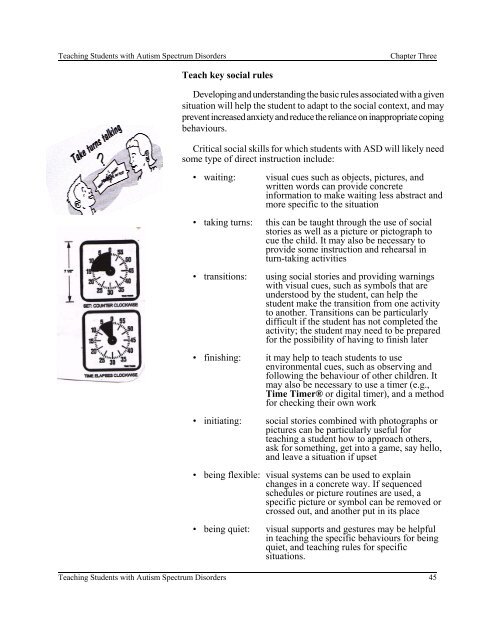Teaching Students with Autism Spectrum Disorders
Teaching Students with Autism Spectrum Disorders
Teaching Students with Autism Spectrum Disorders
Create successful ePaper yourself
Turn your PDF publications into a flip-book with our unique Google optimized e-Paper software.
<strong>Teaching</strong> <strong>Students</strong> <strong>with</strong> <strong>Autism</strong> <strong>Spectrum</strong> <strong>Disorders</strong> Chapter Three<br />
Teach key social rules<br />
Developing and understanding the basic rules associated <strong>with</strong> a given<br />
situation will help the student to adapt to the social context, and may<br />
prevent increased anxiety and reduce the reliance on inappropriate coping<br />
behaviours.<br />
Critical social skills for which students <strong>with</strong> ASD will likely need<br />
some type of direct instruction include:<br />
• waiting: visual cues such as objects, pictures, and<br />
written words can provide concrete<br />
information to make waiting less abstract and<br />
more specific to the situation<br />
• taking turns: this can be taught through the use of social<br />
stories as well as a picture or pictograph to<br />
cue the child. It may also be necessary to<br />
provide some instruction and rehearsal in<br />
turn-taking activities<br />
• transitions: using social stories and providing warnings<br />
<strong>with</strong> visual cues, such as symbols that are<br />
understood by the student, can help the<br />
student make the transition from one activity<br />
to another. Transitions can be particularly<br />
difficult if the student has not completed the<br />
activity; the student may need to be prepared<br />
for the possibility of having to finish later<br />
• finishing: it may help to teach students to use<br />
environmental cues, such as observing and<br />
following the behaviour of other children. It<br />
may also be necessary to use a timer (e.g.,<br />
Time Timer® or digital timer), and a method<br />
for checking their own work<br />
• initiating: social stories combined <strong>with</strong> photographs or<br />
pictures can be particularly useful for<br />
teaching a student how to approach others,<br />
ask for something, get into a game, say hello,<br />
and leave a situation if upset<br />
• being flexible: visual systems can be used to explain<br />
changes in a concrete way. If sequenced<br />
schedules or picture routines are used, a<br />
specific picture or symbol can be removed or<br />
crossed out, and another put in its place<br />
• being quiet: visual supports and gestures may be helpful<br />
in teaching the specific behaviours for being<br />
quiet, and teaching rules for specific<br />
situations.<br />
<strong>Teaching</strong> <strong>Students</strong> <strong>with</strong> <strong>Autism</strong> <strong>Spectrum</strong> <strong>Disorders</strong> 45

















